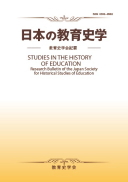57 巻
選択された号の論文の47件中1~47を表示しています
- |<
- <
- 1
- >
- >|
表紙等
-
原稿種別: 表紙
2014 年 57 巻 p. Cover1-
発行日: 2014/10/01
公開日: 2017/06/01
PDF形式でダウンロード (7441K) -
原稿種別: 付録等
2014 年 57 巻 p. App1-
発行日: 2014/10/01
公開日: 2017/06/01
PDF形式でダウンロード (8K)
目次
-
原稿種別: 目次
2014 年 57 巻 p. 1-3
発行日: 2014/10/01
公開日: 2017/06/01
PDF形式でダウンロード (118K)
研究論文
-
原稿種別: 付録等
2014 年 57 巻 p. 5-
発行日: 2014/10/01
公開日: 2017/06/01
PDF形式でダウンロード (4K) -
原稿種別: 本文
2014 年 57 巻 p. 6-18
発行日: 2014/10/01
公開日: 2017/06/01
PDF形式でダウンロード (1381K) -
原稿種別: 本文
2014 年 57 巻 p. 19-31
発行日: 2014/10/01
公開日: 2017/06/01
PDF形式でダウンロード (1467K) -
原稿種別: 本文
2014 年 57 巻 p. 32-44
発行日: 2014/10/01
公開日: 2017/06/01
PDF形式でダウンロード (1318K) -
原稿種別: 本文
2014 年 57 巻 p. 45-57
発行日: 2014/10/01
公開日: 2017/06/01
PDF形式でダウンロード (1470K) -
原稿種別: 本文
2014 年 57 巻 p. 58-70
発行日: 2014/10/01
公開日: 2017/06/01
PDF形式でダウンロード (4539K) -
原稿種別: 本文
2014 年 57 巻 p. 71-83
発行日: 2014/10/01
公開日: 2017/06/01
PDF形式でダウンロード (1906K) -
原稿種別: 本文
2014 年 57 巻 p. 84-96
発行日: 2014/10/01
公開日: 2017/06/01
PDF形式でダウンロード (1455K) -
原稿種別: 本文
2014 年 57 巻 p. 97-109
発行日: 2014/10/01
公開日: 2017/06/01
PDF形式でダウンロード (1446K)
教育史学会第57回大会記録
-
原稿種別: 付録等
2014 年 57 巻 p. 111-
発行日: 2014/10/01
公開日: 2017/06/01
PDF形式でダウンロード (7K) -
原稿種別: 付録等
2014 年 57 巻 p. 112-114
発行日: 2014/10/01
公開日: 2017/06/01
PDF形式でダウンロード (174K) -
原稿種別: 付録等
2014 年 57 巻 p. 115-
発行日: 2014/10/01
公開日: 2017/06/01
PDF形式でダウンロード (28K)
教育史学会第57回大会シンポジウム
-
原稿種別: 本文
2014 年 57 巻 p. 116-117
発行日: 2014/10/01
公開日: 2017/06/01
PDF形式でダウンロード (162K) -
原稿種別: 本文
2014 年 57 巻 p. 118-122
発行日: 2014/10/01
公開日: 2017/06/01
PDF形式でダウンロード (578K) -
原稿種別: 本文
2014 年 57 巻 p. 123-127
発行日: 2014/10/01
公開日: 2017/06/01
PDF形式でダウンロード (570K) -
原稿種別: 本文
2014 年 57 巻 p. 128-133
発行日: 2014/10/01
公開日: 2017/06/01
PDF形式でダウンロード (841K) -
原稿種別: 本文
2014 年 57 巻 p. 134-137
発行日: 2014/10/01
公開日: 2017/06/01
PDF形式でダウンロード (410K) -
原稿種別: 本文
2014 年 57 巻 p. 138-140
発行日: 2014/10/01
公開日: 2017/06/01
PDF形式でダウンロード (373K) -
原稿種別: 本文
2014 年 57 巻 p. 141-143
発行日: 2014/10/01
公開日: 2017/06/01
PDF形式でダウンロード (405K)
書評
-
原稿種別: 付録等
2014 年 57 巻 p. 145-
発行日: 2014/10/01
公開日: 2017/06/01
PDF形式でダウンロード (3K) -
原稿種別: 本文
2014 年 57 巻 p. 146-148
発行日: 2014/10/01
公開日: 2017/06/01
PDF形式でダウンロード (456K) -
原稿種別: 本文
2014 年 57 巻 p. 149-151
発行日: 2014/10/01
公開日: 2017/06/01
PDF形式でダウンロード (439K) -
原稿種別: 本文
2014 年 57 巻 p. 151-154
発行日: 2014/10/01
公開日: 2017/06/01
PDF形式でダウンロード (611K) -
原稿種別: 本文
2014 年 57 巻 p. 154-157
発行日: 2014/10/01
公開日: 2017/06/01
PDF形式でダウンロード (579K) -
原稿種別: 本文
2014 年 57 巻 p. 157-160
発行日: 2014/10/01
公開日: 2017/06/01
PDF形式でダウンロード (573K) -
原稿種別: 本文
2014 年 57 巻 p. 160-163
発行日: 2014/10/01
公開日: 2017/06/01
PDF形式でダウンロード (584K) -
原稿種別: 本文
2014 年 57 巻 p. 163-165
発行日: 2014/10/01
公開日: 2017/06/01
PDF形式でダウンロード (443K) -
原稿種別: 本文
2014 年 57 巻 p. 165-168
発行日: 2014/10/01
公開日: 2017/06/01
PDF形式でダウンロード (578K) -
原稿種別: 本文
2014 年 57 巻 p. 168-171
発行日: 2014/10/01
公開日: 2017/06/01
PDF形式でダウンロード (548K)
図書紹介
-
原稿種別: 付録等
2014 年 57 巻 p. 173-
発行日: 2014/10/01
公開日: 2017/06/01
PDF形式でダウンロード (4K) -
原稿種別: 本文
2014 年 57 巻 p. 174-175
発行日: 2014/10/01
公開日: 2017/06/01
PDF形式でダウンロード (319K) -
原稿種別: 本文
2014 年 57 巻 p. 175-177
発行日: 2014/10/01
公開日: 2017/06/01
PDF形式でダウンロード (458K) -
原稿種別: 本文
2014 年 57 巻 p. 177-180
発行日: 2014/10/01
公開日: 2017/06/01
PDF形式でダウンロード (576K) -
原稿種別: 本文
2014 年 57 巻 p. 180-181
発行日: 2014/10/01
公開日: 2017/06/01
PDF形式でダウンロード (330K) -
原稿種別: 本文
2014 年 57 巻 p. 181-183
発行日: 2014/10/01
公開日: 2017/06/01
PDF形式でダウンロード (444K) -
原稿種別: 本文
2014 年 57 巻 p. 183-185
発行日: 2014/10/01
公開日: 2017/06/01
PDF形式でダウンロード (434K) -
原稿種別: 本文
2014 年 57 巻 p. 185-187
発行日: 2014/10/01
公開日: 2017/06/01
PDF形式でダウンロード (438K) -
原稿種別: 本文
2014 年 57 巻 p. 187-189
発行日: 2014/10/01
公開日: 2017/06/01
PDF形式でダウンロード (437K) -
原稿種別: 本文
2014 年 57 巻 p. 189-191
発行日: 2014/10/01
公開日: 2017/06/01
PDF形式でダウンロード (433K) -
原稿種別: 本文
2014 年 57 巻 p. 191-192
発行日: 2014/10/01
公開日: 2017/06/01
PDF形式でダウンロード (324K)
編集規程・編集後記
-
原稿種別: 付録等
2014 年 57 巻 p. App2-
発行日: 2014/10/01
公開日: 2017/06/01
PDF形式でダウンロード (61K) -
原稿種別: 付録等
2014 年 57 巻 p. App4-
発行日: 2014/10/01
公開日: 2017/06/01
PDF形式でダウンロード (66K) -
原稿種別: 付録等
2014 年 57 巻 p. App5-
発行日: 2014/10/01
公開日: 2017/06/01
PDF形式でダウンロード (55K) -
原稿種別: 表紙
2014 年 57 巻 p. Cover2-
発行日: 2014/10/01
公開日: 2017/06/01
PDF形式でダウンロード (38K)
- |<
- <
- 1
- >
- >|
